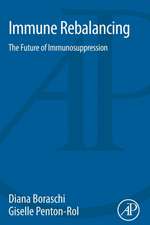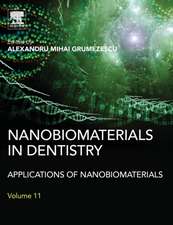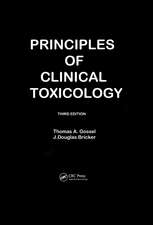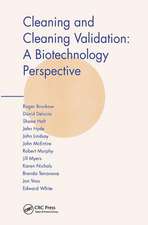Underexplored Medicinal Plants from Sub-Saharan Africa: Plants with Therapeutic Potential for Human Health
Editat de Namrita Lallen Limba Engleză Paperback – 8 noi 2019
- Explores the therapeutic potential of a comprehensive selection of underexplored and underutilized medicinal plants in sub-Sahara Africa
- Provides a summary table of structures of any known natural products, including details of plant source (chapter) and observed activity (e.g. anticancer, antibacterial)
- Includes contributions from experts from South African, Mauritius, Seychelles, Cameroon and Nigeria
Preț: 598.69 lei
Preț vechi: 785.86 lei
-24% Nou
Puncte Express: 898
Preț estimativ în valută:
114.56€ • 119.91$ • 95.35£
114.56€ • 119.91$ • 95.35£
Carte tipărită la comandă
Livrare economică 24 martie-07 aprilie
Preluare comenzi: 021 569.72.76
Specificații
ISBN-13: 9780128168141
ISBN-10: 0128168145
Pagini: 358
Ilustrații: 50 illustrations (20 in full color)
Dimensiuni: 152 x 229 mm
Editura: ELSEVIER SCIENCE
ISBN-10: 0128168145
Pagini: 358
Ilustrații: 50 illustrations (20 in full color)
Dimensiuni: 152 x 229 mm
Editura: ELSEVIER SCIENCE
Public țintă
Professors and graduate students in the areas of medicinal plant science, pharmacognosy, phyto-chemistry, phytomedicine and herbal science courses, as well as those discovery and development scientists engaged in natural product research in the pharmaceutical and cosmeceutical industriesCuprins
1. Acalypha integrifolia subsp. integrifolia
Nawraj Rummun, Cláudia Baider, Theeshan Bahorun, and Vidushi S. Neergheen-Bhujun
2. Aloe lomatophylloides
Joyce Govinden Soulange, Devina Lobine, Mala Ranghoo Sanmukhiya, Melanie J.R. Howes, and Paul Chazot
3. Aloe macra
Joyce Govinden Soulange, Mala Ranghoo Sanmukhiya, Devina Lobine, Christophe Lavergne, Melanie J.R. Howes, and Paul Chazot
4. Aloe purpurea
Mala Ranghoo Sanmukhiya, Joyce Govinden Soulange, Devina Lobine, Melanie J.R. Howes, and Paul Chazot
5. Aloe spicata
Bianca Fibrich and Namrita Lall
6. Aloe tormentorii
Devina Lobine, Mala Ranghoo Sanmukhiya, Joyce Govinden Soulange, Kersley Pynee, Melanie J.R. Howes, and Paul Chazot
7. Bauhinia galpinii
Joseph O. Erhabo and Lyndy J. McGaw
8. Bruguiera gymnorhiza
Nabilah Sadeer, Nadeem Nazurally, Rajesh Jeewon, and Fawzi Mahomoodally
9. Buddleja saligna
Danielle Twilley and Namrita Lall
10. Combretum molle
Sunelle Rademan and Namrita Lall
11. Commelina benghalensis
Bianca Fibrich and Namrita Lall
12. Elaeodendron transvaalense
Emmanual T. Tshikalange and Fatimah Lawal
13. Equisetum ramosissimum
Karina Szuman and Namrita Lall
14. Eriosema kraussianum
Riana Kleynhans, Ivy Masefako Makena, and Babalwa Matsiliza-Mlathi
15. Erythrophleum lasianthum
Sipho Chauke and Quenton Kritzinger
16. Euclea natalensis
Carel B. Oosthuizen and Namrita Lall
17. Eugenia crassipetala
Mala Ranghoo Sanmukhiya, Joyce Govinden Soulange, Jean-Claude Sevastian, Avinash Budloo, Rachel Brunchault, and Srutee Ramprosand
18. Eugenia tinifolia
Nawraj Rummun, Cláudia Baider, Theeshan Bahorun, and Vidushi S. Neergheen-Bhujun
19. Ficus glumosa
Analike Blom van Staden and Namrita Lall
20. Ficus lutea
Analike Blom van Staden and Namrita Lall
21. Ficus sur
Analike Blom van Staden and Namrita Lall
22. Greyia radlkoferi
Marco Nuno De Canha and Namrita Lall
23. Haemanthus albiflos
Balungile Madikizela and Lyndy Joy McGaw
24. Heteropyxis canescens
Dikonketso Bodiba and Namrita Lall
25. Heteropyxis dehniae
Dikonketso Bodiba and Namrita Lall
26. Hypericum revolutum subsp. revolutum
Analike Blom van Staden and Namrita Lall
27. Juncus effusus
Carel B. Oosthuizen, Matthew Fisher, and Namrita Lall
28. Lannea schweinfurthii
Fatimah Lawal and T.E. Tshikalange
29. Lippia scaberrima
Anna-mari Kok and Namrita Lall
30. Newtonia buchananii
Katlego Ellena Motlhatlego and Lyndy J. McGaw
31. Nymphaea caerulea
Carel B. Oosthuizen, Matthew Fisher, and Namrita Lall
32. Ocimum labiatum
Isa A. Lambrechts and Namrita Lall
33. Phyllanthus phillyreifolius
Mohamad Fawzi Mahomoodally, Beebee Noushreen Kissoon, and Sameerchand Pudaruth
34. Plantago longissima
Bianca Fibrich and Namrita Lall
35. Plectranthus ecklonii
Isa A. Lambrechts and Namrita Lall
36. Plectranthus neochilus
Isa A. Lambrechts and Namrita Lall
37. Rapanea melanophloeos
Analike Blom van Staden and Namrita Lall
38. Ravenala madagascariensis
Shanoo Suroowan and Fawzi Mahomoodally
39. Searsia lancea
Murunwa Madzinga and Quenton Kritzinger
40. Siphonochilus aethiopicus
Anna-Mari Reid and Namrita Lall
41. Stillingia lineata subsp. lineata
Nawraj Rummun, Cláudia Baider, Theeshan Bahorun, and Vidushi S. Neergheen-Bhujun
42. Terminalia bentzoe subsp. bentzoe
Nawraj Rummun, Cláudia Baider, Theeshan Bahorun, and Vidushi S. Neergheen-Bhujun
43. Terminalia prunioides
Fatimah Lawal and T.E. Tshikalange
44. Vigna unguiculata
Sipho Chauke and Quenton Kritzinger
45. Wikstroemia indica
Shanoo Suroowan and Fawzi Mahomoodally
46. Zantedeschia aethiopica
Karina Szuman and Namrita Lall
Nawraj Rummun, Cláudia Baider, Theeshan Bahorun, and Vidushi S. Neergheen-Bhujun
2. Aloe lomatophylloides
Joyce Govinden Soulange, Devina Lobine, Mala Ranghoo Sanmukhiya, Melanie J.R. Howes, and Paul Chazot
3. Aloe macra
Joyce Govinden Soulange, Mala Ranghoo Sanmukhiya, Devina Lobine, Christophe Lavergne, Melanie J.R. Howes, and Paul Chazot
4. Aloe purpurea
Mala Ranghoo Sanmukhiya, Joyce Govinden Soulange, Devina Lobine, Melanie J.R. Howes, and Paul Chazot
5. Aloe spicata
Bianca Fibrich and Namrita Lall
6. Aloe tormentorii
Devina Lobine, Mala Ranghoo Sanmukhiya, Joyce Govinden Soulange, Kersley Pynee, Melanie J.R. Howes, and Paul Chazot
7. Bauhinia galpinii
Joseph O. Erhabo and Lyndy J. McGaw
8. Bruguiera gymnorhiza
Nabilah Sadeer, Nadeem Nazurally, Rajesh Jeewon, and Fawzi Mahomoodally
9. Buddleja saligna
Danielle Twilley and Namrita Lall
10. Combretum molle
Sunelle Rademan and Namrita Lall
11. Commelina benghalensis
Bianca Fibrich and Namrita Lall
12. Elaeodendron transvaalense
Emmanual T. Tshikalange and Fatimah Lawal
13. Equisetum ramosissimum
Karina Szuman and Namrita Lall
14. Eriosema kraussianum
Riana Kleynhans, Ivy Masefako Makena, and Babalwa Matsiliza-Mlathi
15. Erythrophleum lasianthum
Sipho Chauke and Quenton Kritzinger
16. Euclea natalensis
Carel B. Oosthuizen and Namrita Lall
17. Eugenia crassipetala
Mala Ranghoo Sanmukhiya, Joyce Govinden Soulange, Jean-Claude Sevastian, Avinash Budloo, Rachel Brunchault, and Srutee Ramprosand
18. Eugenia tinifolia
Nawraj Rummun, Cláudia Baider, Theeshan Bahorun, and Vidushi S. Neergheen-Bhujun
19. Ficus glumosa
Analike Blom van Staden and Namrita Lall
20. Ficus lutea
Analike Blom van Staden and Namrita Lall
21. Ficus sur
Analike Blom van Staden and Namrita Lall
22. Greyia radlkoferi
Marco Nuno De Canha and Namrita Lall
23. Haemanthus albiflos
Balungile Madikizela and Lyndy Joy McGaw
24. Heteropyxis canescens
Dikonketso Bodiba and Namrita Lall
25. Heteropyxis dehniae
Dikonketso Bodiba and Namrita Lall
26. Hypericum revolutum subsp. revolutum
Analike Blom van Staden and Namrita Lall
27. Juncus effusus
Carel B. Oosthuizen, Matthew Fisher, and Namrita Lall
28. Lannea schweinfurthii
Fatimah Lawal and T.E. Tshikalange
29. Lippia scaberrima
Anna-mari Kok and Namrita Lall
30. Newtonia buchananii
Katlego Ellena Motlhatlego and Lyndy J. McGaw
31. Nymphaea caerulea
Carel B. Oosthuizen, Matthew Fisher, and Namrita Lall
32. Ocimum labiatum
Isa A. Lambrechts and Namrita Lall
33. Phyllanthus phillyreifolius
Mohamad Fawzi Mahomoodally, Beebee Noushreen Kissoon, and Sameerchand Pudaruth
34. Plantago longissima
Bianca Fibrich and Namrita Lall
35. Plectranthus ecklonii
Isa A. Lambrechts and Namrita Lall
36. Plectranthus neochilus
Isa A. Lambrechts and Namrita Lall
37. Rapanea melanophloeos
Analike Blom van Staden and Namrita Lall
38. Ravenala madagascariensis
Shanoo Suroowan and Fawzi Mahomoodally
39. Searsia lancea
Murunwa Madzinga and Quenton Kritzinger
40. Siphonochilus aethiopicus
Anna-Mari Reid and Namrita Lall
41. Stillingia lineata subsp. lineata
Nawraj Rummun, Cláudia Baider, Theeshan Bahorun, and Vidushi S. Neergheen-Bhujun
42. Terminalia bentzoe subsp. bentzoe
Nawraj Rummun, Cláudia Baider, Theeshan Bahorun, and Vidushi S. Neergheen-Bhujun
43. Terminalia prunioides
Fatimah Lawal and T.E. Tshikalange
44. Vigna unguiculata
Sipho Chauke and Quenton Kritzinger
45. Wikstroemia indica
Shanoo Suroowan and Fawzi Mahomoodally
46. Zantedeschia aethiopica
Karina Szuman and Namrita Lall
Recenzii
"Overall, this book will be highly prized by readers from different backgrounds. Pharmacognosists and phytochemists will appreciate the description of compounds isolated and biological data provided in the book. Ethnobotanists will value the traditional uses detailed in each monograph. International and national agencies can use this book to guide their policy relative to quality control and identification of medicinal plants. Students from various fields, especially from pharmacognosy, will learn about standardized methods used to create monographs. Finally, amateur botanists and persons interested in understudied medicinal plants will be able to recognize them in the field using high-quality photographs found in this book. Overall, this book is a useful and accessible resource on selected plants from sub-Saharan Africa which contributes to their safe and effective use in traditional medicine. We recommend it to anyone who is interested in medicinal plants." --Frontiers in Pharmacology
"Reviewing a book of this magnitude is quite a humbling opportunity. Given the vastness of the human cultural spread and their interaction with plants of diverse habitats, the idea of picking up the cudgel to edit a book of this nature must have taken a lot of courage from the editor. This book of 360 pages has encompassed, in its precincts, a large amount of plants description (46 species) and their traditional medicinal use. The authors have mentioned the necessity of future exploration, authentication and standardization of plant products before the application by the practitioners or the patients. Thus, the book has worked as the starting line of the new world of exploration of underutilized plants in their therapeutic use. Under the present changing times, the climate is showing its vagaries every so often in one part of the world or the other, tremendously impacting the life of plants and animals on the face of the earth. Needless to say, the world is going to see new products and prototypes from plants in more modern areas, and the kaleidoscope of the worlds’ ethnopharmacological ecosystem is bound to change. Putting it simply, it was found worthwhile by the authors that, at the basic level, a solid knowledge of all the plants, explored and otherwise, must be brought together to make headway. It is thus a unique compilation of 46 chapters, each one dedicated to one underutilized plant from Africa. In its turn, a team of scientists carefully authored each plant. In terms of compaction of knowledge, this book reflects a DNA like coiling and super-coiling. The plants are alphabetically arranged, and the entire book follows a set accepted format including; references, abbreviations, diagrams and author citations. In addition, each Chapter in this book includes exhaustive details up to the molecular level. Furthermore, it covers the vivid description of the plant at the taxonomical, anatomical, and ethnobotanical levels. The latter is of great importance as there exists several herbalists who have created medical wonders by using simple and common plants with unconventional wisdom. This book will be one step further in integrating the MUTIES of Africa and the BUTIS of India in pursuance of human welfare." --South African Journal of Botany
"Reviewing a book of this magnitude is quite a humbling opportunity. Given the vastness of the human cultural spread and their interaction with plants of diverse habitats, the idea of picking up the cudgel to edit a book of this nature must have taken a lot of courage from the editor. This book of 360 pages has encompassed, in its precincts, a large amount of plants description (46 species) and their traditional medicinal use. The authors have mentioned the necessity of future exploration, authentication and standardization of plant products before the application by the practitioners or the patients. Thus, the book has worked as the starting line of the new world of exploration of underutilized plants in their therapeutic use. Under the present changing times, the climate is showing its vagaries every so often in one part of the world or the other, tremendously impacting the life of plants and animals on the face of the earth. Needless to say, the world is going to see new products and prototypes from plants in more modern areas, and the kaleidoscope of the worlds’ ethnopharmacological ecosystem is bound to change. Putting it simply, it was found worthwhile by the authors that, at the basic level, a solid knowledge of all the plants, explored and otherwise, must be brought together to make headway. It is thus a unique compilation of 46 chapters, each one dedicated to one underutilized plant from Africa. In its turn, a team of scientists carefully authored each plant. In terms of compaction of knowledge, this book reflects a DNA like coiling and super-coiling. The plants are alphabetically arranged, and the entire book follows a set accepted format including; references, abbreviations, diagrams and author citations. In addition, each Chapter in this book includes exhaustive details up to the molecular level. Furthermore, it covers the vivid description of the plant at the taxonomical, anatomical, and ethnobotanical levels. The latter is of great importance as there exists several herbalists who have created medical wonders by using simple and common plants with unconventional wisdom. This book will be one step further in integrating the MUTIES of Africa and the BUTIS of India in pursuance of human welfare." --South African Journal of Botany



















